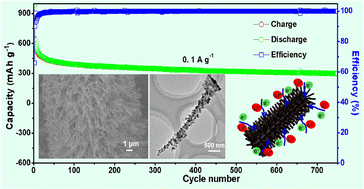FeF3@C nanotube arrays grown on carbon fabric as a free-standing cathode for lithium-ion batteries†
Abstract
A self-supported, free-standing, and carbon-wrapped FeF3@C nanotube array was directly fabricated on carbon fiber cloth (CFC) via in situ deposition and etching using a Ni–Co basic carbonate precursor as a template combined with a facile gas fluorination method. X-ray photoelectron spectroscopy and transmission electron microscopy characterization confirms that FeF3@C-CFC has a uniform nanotube structure, which ensures good infiltration of the electrolyte and provides more pathways for Li+/electron transport, thus achieving superior rate capability. Furthermore, the introduction of carbon not only improves the electronic conductivity but also provides a buffer matrix to protect the nanotube structure from destruction. Due to the unique nanotube array, this FeF3@C-CFC cathode possesses a capacity of over 300 mA h g−1 at 0.1 A g−1 after 700 reciprocating cycles and achieves 235 mA h g−1 at 0.4 A g−1 over 300 cycles. FeF3@C-CFC maintains a specific capacity of 676.7, 563.9, 487, 366.6, 250.5 and 123.4 mA h g−1 at 0.1, 0.2, 0.5, 1.0, 2.0 and 5.0 A g−1, respectively. This design strategy opens a window to free-standing cathode fabrication and will promote the development of flexible Li-ion batteries.

- This article is part of the themed collection: Materials Chemistry Frontiers Emerging Investigator Series 2022–2023


 Please wait while we load your content...
Please wait while we load your content...